Congratulations on your new cat or kitten
We are so glad you have made the decision to adopt a cat from Animal Aid!
If you are having any problems or have any questions please contact the shelter as soon as you can.
Coldstream
35 Killara Road Coldstream
03 9739 0300
enquiries@animalaid.org.au
Animal Aid Gippsland (Sale)
111 Hopkins Road Fulham
03 5144 5940
aag@animalaid.org.au
Animal Aid East Gippsland (Bairnsdale)
40 Giles Road Bairnsdale
03 5152 1389
aaeg@animalaid.org.au
BRINGING YOUR CAT HOME
Car Safety
A car is a strange and new environment for your cat. Knowing how to prepare your cat for any car ride is important for both safety and comfort. Cats don’t always make the best passengers and the last thing you want is a set of claws embedded in your back as you cruise down the highway!
Whenever you travel by car, always make sure your cat is as comfortable as possible, making your life much easier.
Travelling essentials
Before embarking on your journey, make sure you have a:
- Large pet carrier.
- Light sheet or towel to cover the carrier.
- Small disposable litter tray to place into the carrier.
- Food and water bowl.
Always keep your cat in the carrier, which should be securely fastened to reduce the risk of injury.


Tips for a comfortable journey
- Introduce your cat to car travel gradually. For example, start with a short trip around the block and slowly lead up to a longer journey.
- A waterproof sheet will come in handy for the car seat.
- Always carry paper towels and a safe disinfectant in case of an accident.
- Take along your cat’s favourite toy or blanket.
- It can be a good idea not to feed your cat too large a meal prior to travel. Some animals are likely to experience carsickness.
- Open the window so your cat gets adequate ventilation.
- Never leave your cat in a hot car, even for a few minutes.
At home
Now that your new cat is home he/she is bound to feel a little frightened about the new faces and surroundings. Although it is an exciting time for you and your family, don’t overwhelm the cat with too much handling, lots of visitors, loud noises and excessive activity in the first few days. Let the cat gain his/her confidence by being in a calm and quiet environment.
When you arrive home, leave your cat in the box until you have set up their facilities. You will need to set up a bed and feeding area with some entertaining toys, and set up the litter tray in a separate area away from the food (however it can be in the same room).
After you have ensured all doors and windows are CLOSED and there are no means of escape you can take your cat out of their box and place them on their bed. Now step back and allow the cat to explore. Do not make too much of a fuss over your cat; give them space and they will come to you when they are ready.
Once your cat appears relaxed and comfortable with the situation, offer a small amount of food to welcome them into their new home. Be sure to familiarize your cat with the location of their litter tray to help prevent any accidents.
It is best to confine the cat to the house for 2-4 weeks (or 6 months for kittens) so it becomes familiar with its new owners, surroundings and routines. If the cat appears to be uncomfortable or anxious, you are best to confine him/her to only one room and then gradually introduce them to other parts of the house over the next few weeks until the cat appears relaxed with the environment.
IF YOU HAVE ANY CONCERNS PLEASE CONTACT THE SHELTER FOR ADVICE.
WE ARE HERE TO HELP BOTH YOU AND YOUR NEW FAMILY MEMBER SETTLE IN TO THE FAMILY ROUTINE.
Meeting your other pets
Before introducing your new cat to your existing pets, wait until the cat has settled in and is feeling comfortable in the new surroundings.
Meeting your dog
When you are ready to introduce your new cat to your dog bring the dog inside on a lead. Have some of your dog’s favorite treats on hand to reward good quiet behavior from your dog. Let the cat approach the dog when it is ready rather than holding the cat in your arms and forcing it to get too close too soon. Your cat may be frightened by the sight and smell of your dog, so don’t rush the introduction; give both animals time and plenty of space until they start to relax. When a cat becomes frightened and runs, the instinct of many dogs is to chase, so don’t let this happen. Keep a good control on the situation and your dog on the lead.
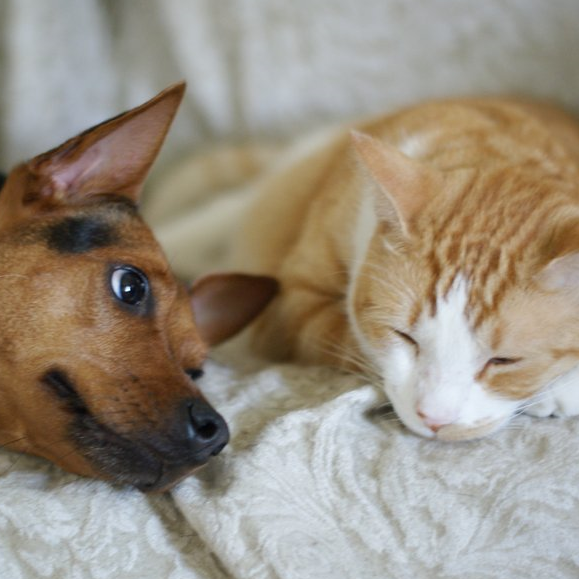

Meeting your cat
The ideal introduction between a new cat and your existing cat would be to provide a situation in which the cats can see and smell each other without being able to physically interact. This will provide you with the opportunity to gauge their initial reactions in a very controlled setting.
It is normal for a bit of hissing and growling and even the odd smack or two (you have an intruder in the house after all!). Keen supervision is required for all introduction sessions to prevent a situation developing that may become harmful to either cat.
Follow these steps!
- When introducing another feline to an existing cat in your household, make sure the new arrival will not be encroaching on your cat’s territory. I.e. don’t rearrange the resident cats feeding or sleeping arrangements to fit in with the new arrival. But work to preserve the status quo.
- Give the new cat a room of their own (complete with her own bedding, bowls and litter tray) for the first few days. Place something with the scent of each cat on it into the other’s living area to start the introduction process.
- After a few days, confine the resident cat while you allow the new arrival to explore the remainder of the house. While this is taking place, allow the resident cat to check out the newcomer’s room, but keep the door closed. Then return the new cat to her quarters, while the resident cat regains full run of the house.
- Once you feel they are both comfortable with the knowledge that there is another feline in the house, put the new arrival in their carry cage and open the door to their room, so that the resident cat can come in for a 10 minute supervised visit. Repeat this procedure over several days if need be gradually increasing the length of access time.
- When they appear to have accepted each other, bring the resident cat in for a visit, but this time make sure the new arrival is not confined. Have a water pistol on standby, in case you need to break up any cat spats! After all your careful groundwork, hopefully this will not be necessary.
- After successful ‘free-range’ visits in the new cat’s room, open the door and allow them both access to the rest of the house.
- For the time being, continue to feed both the cats in separate rooms and maintain separate litter trays. As they become more comfortable with being in close proximity, you can put the food and water bowls in the same room, gradually moving them closer as the cats become friends. The same applies to their litter trays.
- One of the best ways to accustom both cats to sharing the same space is to engage in communal games with them (using a fishing rod toy for instance) so their focus will be on something other than each other. Similarly, introducing an enticing new piece of equipment for their joint pleasure, such as a climbing tree, will often forge a bond of shared experience.
- Just in case there is the occasional cat spat, make sure there are plenty of ‘bolt-holes’ to which your pets can escape in order to keep their distance and have ‘time out’ while resolving their differences. Do not take sides, but allow them to sort things out in their own time and in their own way. Never force them to interact. Cats can become very fond of each other, but only when the agenda setting is their own.
INSIDE VERSES OUTSIDE
Please check with your local Council with regards to any bylaws. Some councils have curfews in place. These curfews vary from council to council but most are that your cat must be contained indoors from dusk to dawn all year round. However, new laws are being introduced, for example if you live in the Shire of Yarra Ranges your cat must be kept on your property at all times, morning and night.
If your cat is outside after curfew and is impounded, there are release fees and infringement fines which are enforced by the local council prior to release of your animal. The fees also vary if your animal is registered or not.
After the 2-4 week confinement period (or 6 months for kittens) and once relaxed in their new surroundings you can start to allow your cat access to outdoors if you so choose. For the first few days accompany the cat outdoors and let it have a small wander for a few minutes at a time. Once you feel confident that the cat seems relaxed with going outdoors, you can start to let them outside for periods during the day, but always ensure they stay in the boundaries of your property and make sure to bring them in at night.
As a preferred method for the outdoors, we highly recommend an enclosure system for your cat. Not only will they be safe during the day, but they will also be freely able to go out at night without fear of other cats or being trapped and impounded by the local council. Most importantly a cat enclosure prevents your cat wandering, being killed on the road or fighting with other cats and becoming a nuisance to your neighbours.
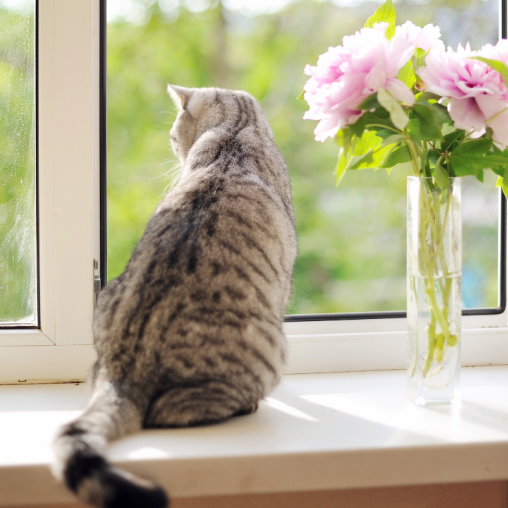
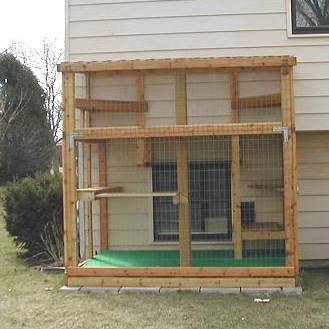
Building a Cat Enclosure
If you’re handy and would like to save money, you can build your own cat proof fencing and cat enclosures. There are many online resources to help wit:
- Cat proof fencing (i.e. modifying existing fencing to make it ‘cat proof’, giving your cat free access to parts of, or your entire, yard)
- Cat enclosures attached to an existing structure (i.e. the house or a shed)
- Free standing cat enclosures.
Ventilation is important if keeping cats in a confined area, especially if you have a number of cats, to prevent spread of disease and respiratory problems from a build up of fumes or stale air.
When training your cat to accept confinement, skip the morning feed and call them in at night to be fed. Don’t feed your cat until they come inside. Your cat will learn quickly that they won’t get fed unless they are home by dusk! Once inside, don’t let your cat out again until morning. If you wish, you can gradually extend the time your cat spends indoors or in an enclosure.
Most cats should adapt well to living indoors and in an enclosure, particularly if they have been kept in this way from an early age. However, adult cats used to roaming outdoors may have more difficulty in adjusting. If this is the case, you can consult your vet for advice. Desexing cats also reduces their desire to roam and helps prevent behavioural problems.
When confining cats for long periods you must enrich their environment. This will prevent them from getting bored or developing behavioural problems.
IDENTIFICATION
It is highly recommended that you put a personal identification tag on your cat’s collar including their name and one or more contact numbers. Personalised identification tags can be ordered through Animal Aid.
Microchipping and registering pets greatly improves their chances of being returned to you if they become lost. If your cat is found wandering off your property and is not identified, they can be seized and impounded. You may have to pay a fine when reclaiming your cat from the pound. If you move house, make sure you update your details with your local council, and also with the microchip registry.
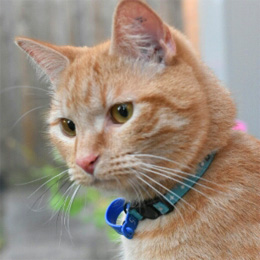
Council Registration
It is a legal requirement that all cats over the age of three months be registered with the council in which they reside, and that they wear their current registration tag at all times. In the state of Victoria registrations must be renewed in April each year and this is your responsibility as a cat owner. Your cat’s registration tag should be attached to an elasticized collar or safety collar, which is firmly fitted.
Microchipping
Microchipping involves the implantation of a chip (about the same size as a grain of rice) under the skin between your cat’s shoulder blades. The chip carries a 15 digit number which is linked via a computer database to your details. This means that if your cat is lost and taken to a vet or a pound, they could be scanned and identified as belonging to you and quickly returned. Microchipping is a good way to ensure that your cat is always identifiable, even without a collar on. Microchipping does not replace a normal council registration.
All animals adopted from Animal Aid have already been implanted with a microchip and you will have filled out the appropriate forms during the adoption process. Remember to ensure that your details are kept current; you can update any of your information via the Central Animal Records website.
HEALTH NEEDS
Worming and Flea Treatments
We recommend worming and flea treatment on a regular basis especially if you allow your cat outside.
Advocate is a wormer and flea treatment all in one, however it does not cover tapeworm. It is recommended to administer a tape wormer tablet using the Bayer – Drontal at the same time as using Advocate especially if your cat goes outside.
– Cats aged between 3 and 6 months of age should be wormed monthly
– Cats over 6 months of age should be wormed every 3 months
Vaccinations
Booster vaccinations for cats must be given on the due date shown on their vaccination certificate. If you return to the Animal Aid Veterinary Clinic at Coldstream the next vaccination will be administered at a reduced price – see the voucher enclosed in your adoption pack.
Vaccinations are incredibly important for your cat, particularly to protect your cat from FIV (Feline Immunodeficiency Virus) and Cat Flu.
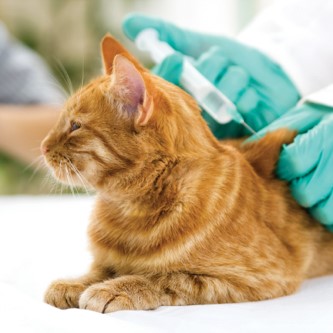
FIV Infection
Feline Immunodeficiency Virus is a virus specific to the cat family. Note: there is no risk of cross infection between the cat and people.
In some cats exposure to the virus leads to clinical signs and symptoms that result in deficiency of the immune system. There are different strains of FIV and some seem more harmful than others. Being FIV positive is not the same as having feline AIDS. FIV positive means that a cat has been infected with the virus, but may not show symptoms for months or years. Symptoms can include; gingivitis, weight loss, poor appetite, fever, chronic conjunctivitis, swollen lymph glands, vomiting and diarrhoea.
There is no specific treatment for the virus, however secondary bacterial infections associated with feline AIDS can be effectively treated with antibiotics. Unfortunately this is usually only a temporary solution until another infection occurs as a result of the cat’s suppressed immune system.
As most cats become infected from bite wounds during fighting, the risk of FIV infection can be minimized by making sure your cat is mostly indoors and vaccinated against FIV.

Cats get the flu too
Cat Flu is a highly contagious respiratory disease in cats and kittens. It is caused by two major cat viruses which are NOT transmissible to dogs and people.
Cat Flu is spread in four ways:
- Directly from infected animals.
- From contaminated food bowls and cages in a cattery.
- From recovered cats which become carriers.
- Passively on human hands and clothing.
Up to 80% of cats may be carriers and the virus is most frequently spread when a cat is under stress.
As Animal Aid deals with over 2000 cats and kittens each year and their history is generally unknown, it is not possible for the shelter to eliminate cat flu entirely. However, we can reduce the severity of the viruses by using infection control.
Because in the vast majority of cases cat flu is only a short term problem, Animal Aid has made the decision to give cats and kittens with mild flu the chance of a new home.
If your pet is on medication when you adopt them, this will be explained to you prior to going home.
If your cat develops the below symptoms please phone the Animal Aid Vet Clinic immediately on 9739 0500 or Animal Aid’s Shelter Cattery on a Sunday on 9739 0300. For emergency situations please contact the Vet Clinic closest to your home.
- Not eating for more than 12 hours after being offered a selection of food such as canned, dry food, home cooked chicken breast and small gourmet tins of cat food.
- Drooling (this may be due to mouth ulcers).
- Breathing with mouth open.
- Very red eyes, running eyes or yellow discharge from the eyes.
- Sneezing, either wet or dry, or green discharge from nose.
- Diarrhoea or stools with blood spots.
- Lethargic, not wanting to do anything but sleep.
The symptoms of cat flu generally last for 2-3 weeks. Cats with flu may not be able to smell their food properly. They may also be fussier than usual with their food and should be offered a selection of foods as listed above. Warming the food may also help to improve its palatability. Remember that we do not know each cat’s individual preference.
Cat flu is highly contagious and we recommend keeping your cat isolated until symptoms have disappeared and that you wash your hands immediately after handling your cat. Wearing an over-shirt is also a good suggestion as the virus can be carried on clothing.
If you’re cat has cat flu and is due for a vaccination it is recommended to delay this until the flu symptoms are only mild as the vaccination may temporarily increase the sneezing. Please be guided by your Vet.
In the vast majority of cases a cat with flu is like a human with a cold and makes a full recovery after a few weeks of TLC. The medications given to cats with flu help to relieve the symptoms but unfortunately do not kill the viruses responsible and therefore will not make the cat get better instantly.
Most importantly always seek veterinarian advice if your cat or kitten is unwell.
DIET AND FELINE BODY CONDITION SCORE CHART
Here at Animal Aid we feed our cats premium quality dry food. We recommend that you feed your adopted cat a high quality, highly palatable food that comes in many varieties and that will cater to your cat’s special needs through the years. We recommend that you divide the serving into two meals i.e. half in the morning and the remaining half for dinner. For kittens, 3 meals a day is recommended; cats are grazers by nature.
If you are adopting from Animal Aid your cat or kitten has been eating Royal Canin dry food, supplemented with good quality wet food. We highly recommend continuing to feed your new cat Royal Canin for a couple of weeks at a minimum.
Changing diet
Cats have a very different digestion to ours, which can be easily upset when you change their food in any way. Royal Canin or other premium brands provide the best all round nutrition for your cat, but if you are going to make a transition to any other food do so gradually, slowly increasing the amount of the new food over a period of at least seven to ten days, so your pet can adjust. Don’t worry if your cat has an upset tummy at the beginning as this is normal.
It is important to adjust this daily amount depending on your cat’s age and activity level. When you visit your veterinarian for your cat’s annual vaccination, ask for advice regarding suitable dry food to keep your new family member at optimum health.
We also recommend supplementing your cat’s diet with an offering of raw chicken necks or wings at least twice a week. These will be an invaluable aid in keeping your cat’s teeth clean. Grass is a popular supplement to your cat’s diet as it aides in healthy digestion. Cats who have access to the outdoors will often seek grass out naturally, but there are seeds /grasses available which can be grown in pots and offered to cats living happy indoor lives.
NOTE: Raw meat can be given as a treat for your cat, but is not nutritionally balanced and is not appropriate as a sole diet. Please don’t feed cow’s milk to cats as this can cause Diarrhoea. Lactose-free milk is available but recommended only as a treat, not as a regular daily serving.
REMEMBER THAT FEEDING DRY FOOD REQUIRES THAT YOUR CAT HAS ACCESS TO FRESH WATER AT ALL TIMES.
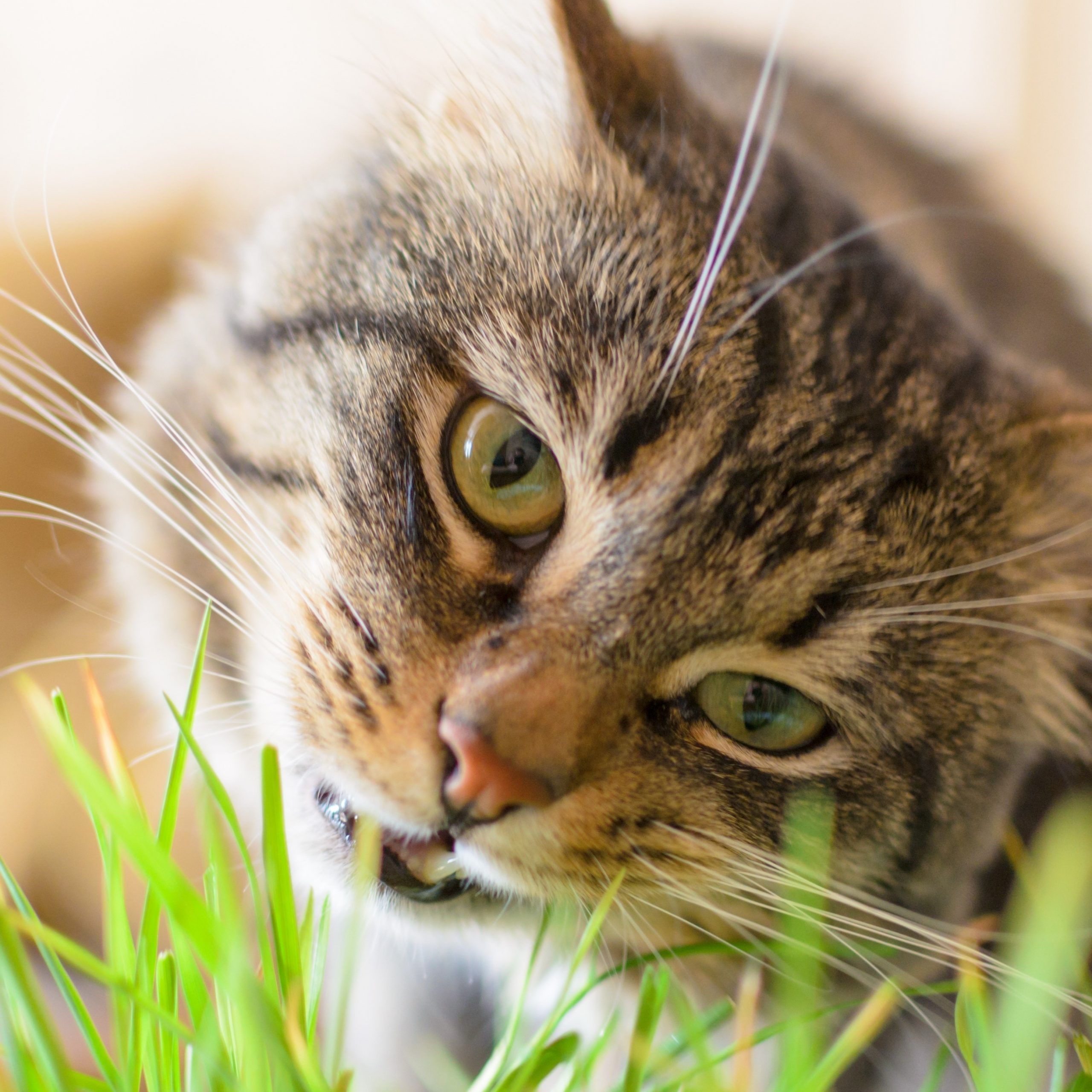
The diet of an adult cat
For a healthy pet, your cat’s diet needs to include the right balance of the six major nutrient groups; proteins, fats and oils, minerals, vitamins, carbohydrates and water.
Any good quality manufactured pet food should provide your cat with this basic nutritional balance. Many are also designed to more accurately fit your cat’s specific needs. For example, if your cat is relatively inactive and indoors, you might consider feeding her a special ‘light’ formula to avoid weight gain. Unless your cat’s circumstances change dramatically, you can continue to follow the same adult feeding routine until your cat reaches their senior years.
What to feed?
You can feed your cat wet or dry food, or a mixture of both, depending on their preference. For example, some cats like to be fed wet food in the morning but snack on dry food during the day.
If you choose a dry food, expect your cat to chew it more actively, eat it over a longer period of time and drink more water. Dry food stays fresh all day so leave it out for your cat to snack on. Unlike dogs, cats prefer to crunch on their dry food and generally find it less attractive when soaked.
Alternatively, if you feed your cat moist food, expect them to eat more in one sitting and drink less. Don’t leave wet food out for longer than 24 hours. Serve all food at room temperature to ensure your cat can taste and smell it properly. You may need to warm up any food stored in the fridge for up to two hours. It’s possible to microwave foods for a short time but be careful of hot spots. Generally, avoid serving food that is too hot or too cold.
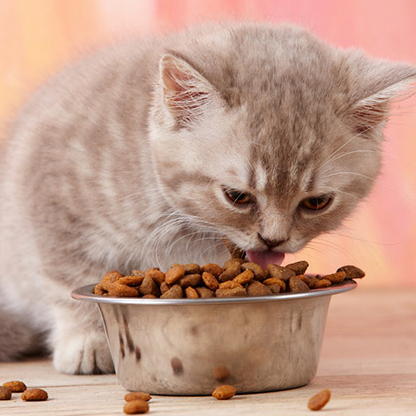
Fresh water – not milk
Fresh, clean drinking water should always be available for your cat in a large metal or ceramic bowl. This helps to keep the kidneys healthy and reduce the risk of any urinary tract infections.
Contrary to popular belief, cow’s milk actually isn’t good for cats as most cats lose the ability to digest lactose shortly after weaning. Make sure you only feed your cat specially formulated ‘cat milk’.
Meat-eaters
Unlike dogs, which can live quite happily on a balanced vegetarian diet, cats will go blind, suffer other debilitating conditions and ultimately die if fed only a vegetarian diet. Cats are obligate carnivores – eating meat is necessary for survival!
Treats and snacks
Despite the temptation to feed your cat scraps from the dinner table, human foods are high in calories and lack many essential nutrients. Doing so risks overfeeding or upsetting the balance of your pet’s diet.
Generally speaking, manufactured treats are a far healthier alternative. Carefully formulated to taste great and complement main meals without upsetting their nutritional balance, many even include nutritional ‘extras’ such as improved dental care.
Quantity
Every cat is an individual and the most important thing is to keep your cat lean and healthy.
When and how to feed
If cats had their way, you would be feeding them 13-16 small meals a day, each one providing about the same amount of calories as a mouse!
Of course, this is can be a tad inconvenient. Cats are essentially creatures of habit, it’s best to stick to a feeding schedule – feed your cat at the same place at the same time every day.
Choose a reasonably quiet area, away from the hustle and bustle of daily life. It’s always a good idea to feed on a surface that is easily cleaned, like a tiled floor or a mat. Place feeding bowls away from the litter tray and, if you have two cats, keep the bowls a reasonable distance apart to avoid confrontations or bullying.
Overweight cats
Overweight cats are more likely to develop diabetes, heart and respiratory problems, bladder stones and arthritis. If weight is a growing concern, try a specially formulated ‘light’ product. Light cat food is lower in fat but still contains all the necessary vitamins and minerals your cat needs.
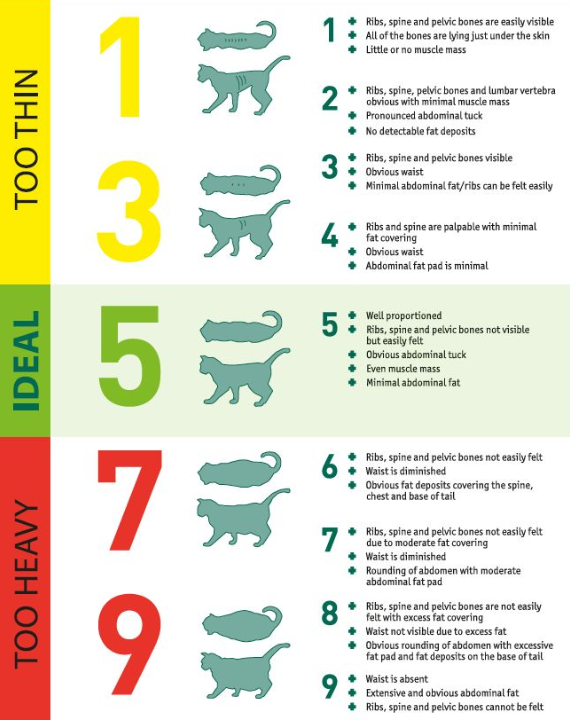
GAMES TO PLAY WITH YOUR CAT
Cats love to play and their favourite games usually draw on their natural hunting instincts. Learn your cat’s favourite games and have hours of fun together.
Why cats like to play
Playing with your cat isn’t just about having fun. It can help your pet express her natural hunting instincts as well as provide healthy exercise. Your cat will begin to play from about four weeks old, for example, wrestling with other kittens. By the time she is seven to eight weeks old, your cat will turn her attention from social play to predatory play with inanimate objects. Play with a variety of games and toys to find out your pet’s favourite. Bells and wind-up toys are often fascinating to cats.

Here are a few cat games they are sure to enjoy:
- A bucket filled with crumpled paper or ping-pong balls can make a useful distraction.
- When your kitten attempts to stalk you, throw a ball to chase.
- Leave a large cardboard box on the floor for diving into and scratching at.
- Glue several boxes together, linked by peepholes, for kitten hide-and-seek.
- Make a sack of fabric stuffed with dried catnip.
- Dangle a ‘fishing pole’ toy with feathers or bells at the end of a string.
- Some cats enjoy chasing and jumping at the light beams from a small flashlight.
- Keep toys out of sight between play sessions: this stops your cat getting too familiar with the objects, so their reappearance is met with enthusiasm.
- There are even I-pad apps that you can download for your cat to play with!
Environmental Enrichment Ideas
Cats are natural hunters and love to wander and explore. Cats living indoors need appropriate mental and physical stimulation to keep them happy and in good health. Toys are a great way to keep your cat entertained and can be either purchased or created and made by you at home. Toys should be rotated on a regular basis to keep them fresh and interesting.
Remember a bored cat is not only an UNHAPPY cat, but may become a troublesome and mischievous one!
Scratching Posts – These provide an area where your cat can stretch and claw and are a must if you like your furniture the way it is! Purchase a post or construct your own. They can be as simple as you like or very fancy. To make your own simply cover a thick post with carpet or rope, similar to a verandah post. Then secure it to a base which is at least half length of the upright pole in width for a stable base and secure it with BOLTS, not nails, as they become loose over a period of time.
Assorted Toys- There is such a great variety of toys for cats these days and most are affordable. You can purchase sticks with feathers, balls, crinkle bags, tunnels, toys on elastic and much more. Toys that promote pouncing and chasing and also encourage hide and seek games are satisfying to your cat and are the cat’s natural instincts.

HOUSEHOLD DANGERS TO CATS
You may think you live in an environment free from cat dangers, but every home is a potential minefield of hazards for your cat.
Rat bait
Most people know that rat bait can also poison cats, but many don’t realise eating a poisoned rat can be fatal too. To reduce the risk of accidental poisoning, put the baits in a place that only the rats can reach. In the roof, between walls, and along known rat runs are all safe places that your pets should not be able to access. Store rat baits safely in the original packaging within another sealed container, and keep this in a high cupboard out of reach of pets and children.
Some rat baits are safer for pets than others, but be careful with any brand. If you think your cat has had contact with rat bait, call your vet immediately.
Snail bait
Most snail baits contain metaldehyde, which is highly toxic to cats. To reduce the risk of accidental poisoning, put the baits in a place your pets can’t access. In your garden, place a barrier around garden beds and garden mesh over the top. Store snail bait in the original packaging within another sealed container and keep this in a high cupboard out of reach of pets and children. If you think your cat has had contact with snail bait, call your vet immediately.
Ant bait
Most of these contain boric acid which is toxic if a cat eats a large amount for its body size. Many ant killers have a sweet smell and taste to attract ants. This can be equally appealing to cats, so always put the ant killer in places your pet can’t get to. Store these insecticides in an air tight container in a high cupboard, out of reach of pets and children. If you think your cat has ingested ant killer, contact your vet immediately.
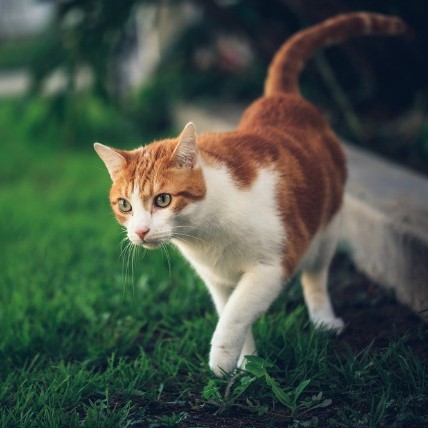
Home office paper shredders
This is a relatively new danger for pets, particularly for cats. Most paper shredders have self-feed and on/off buttons on top of the unit. The machine can often be warm, making it an inviting spot for your cat to lie on, where it can inadvertently switch the shredder on. Cats have had paws, tails and fur caught, so it’s a good habit to keep the shredder turned OFF at the wall and only turn it on when you are using it. You may also want to store it under a desk if possible, where it’s unlikely to be walked over or slept on.
Reclining chairs
These can be a major hazard for pets, especially young kittens. They love to run under and hide in reclining chairs. Kittens are especially likely to climb up inside the chair and curl up for a nap. When someone sits or starts to rock in the chair, pets can become caught or even fatally injured. Always check where your cat is before reclining or closing the recliner on the chair.
Oil burners
The oil used in oil burners is caustic but can tempt some cats with its smell. If licked or swallowed, oil can cause burns to the mouth or esophagus that may become life threatening if left untreated. If you think your cat has ingested oil from an oil burner, contact your vet immediately.

Rubbish bins
Bins are full of hazards, especially for inquisitive animals. If a bin is left open, or can be easily knocked over, pets can pull out dangerous or toxic rubbish such as food wrappers, dental floss, and cigarette butts, or cooked bones and food skewers that could splinter and cause life-threatening damage to the digestive tract. Keep bins covered and out of reach.
Human medications
Medicine that’s safe for you is not necessarily safe for your cat. Some medications, like common headache tablets are highly toxic for animals. If your pet has a health problem, please don’t treat them yourself with human medications or ointments, always contact your vet.
Laundry items
Kittens love playing with clothes pegs and will often chew on them. This is potentially hazardous as pegs can lodge in their mouths or esophagus. Most household cleansers are also dangerous if ingested. Some cats are attracted to the ammonia in floor cleaners or bleach, and may lick a recently cleaned floor. If your pet ingests floor cleaner or bleach it can cause life-threatening burns to the mouth or esophagus, so you should contact your vet immediately.
Electrical cords
It’s recommended to keep all electrical cords out of reach of pets, especially kittens that will often chew, drag and pull on any cords they find. If your pet chews and exposes the wiring it can cause severe injuries. These include burns to the mouth and tongue, and in more serious cases, seizures, difficulty breathing or cardiac arrest. For your family’s safety, if you see your cat chewing an electrical cord or find chew marks on any cord, unplug and replace it immediately.
Toxic plants for cats
There is nothing that adds colour like a bunch of fresh cut flowers around your house. But cat owners should be aware that those lovely flowers can potentially be toxic for cats.
Daffodils, for example, can cause stomach upsets, vomiting, or worse if your cat eats the foliage, flowers or pods. Other plants you may not suspect, like aloe vera, can be toxic for cats as well.
We have listed below some of the many plants that are potentially toxic for cats and should be avoided. Be especially careful with lilies. All parts of these plants (flowers, leaves and stems) are extremely toxic to cats and have caused tragic deaths.
If your cat eats or comes into contact with any of these plants or any other dangerous items, you will need to seek immediate veterinary assistance. We also recommend that you take part of the toxic plant with you for easy identification to help with treatment.
Flowering Plants:
| Amaryllis | Hyacinth | Asian Lily | Hydrangea |
| Autumn Crocus | Iris | Bird of paradise | Kalanchoe |
| Climbing Lily | Lily of the Valley | Cyclamen | Narcissus |
| Daffodil | Poinsettia | Day lily | Elephant ear |
| Rubrum Lily | Easter Lily | Stargazer lily | Wood lily |
| Tiger Lily | Tulip | Gladiola |
Indoor plants: | Ferns: | Perennials: | |
| Aglaonema | Asparagus fern | Aloe Vera | Mother-in-law’s tongue |
| Dracaena Fragrans | Emerald feather | Arum or Calla Lily | Pussy’s Ears |
| Arrowhead vine | Plumosa fern | Morning Glory | Hellebore |
| Dracaena Marginata | Lace fern | Nightshade | Arum or Calla Lily |
| Dracaena Deremensis | Anthurium |
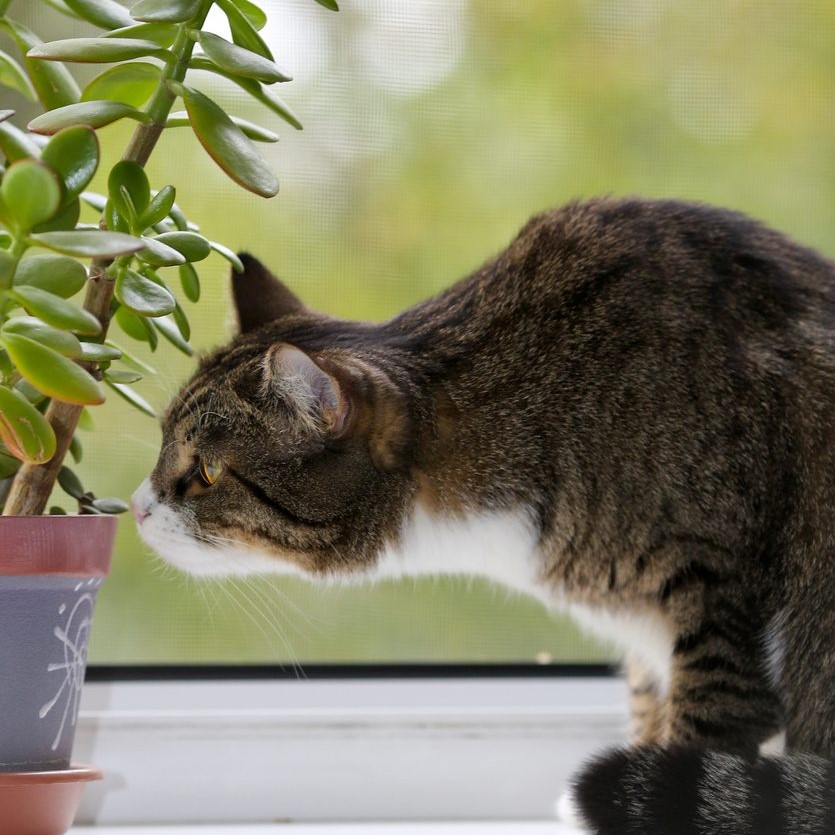
PETS IN SUMMER
Heat stress in animals occurs when they are unable to maintain their normal body temperature on a hot day. On all hot days, especially days of Severe, Extreme or Code Red fire danger, keep your pets as cool as possible. Keeping your pets comfortable on a hot day is your responsibility.
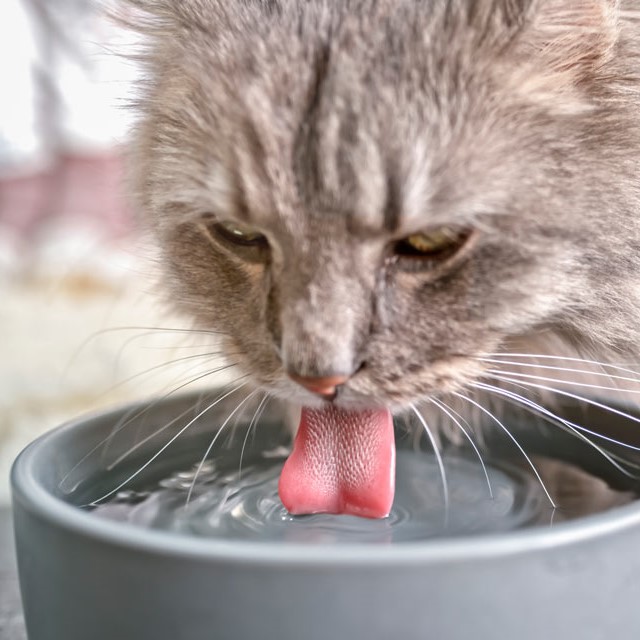
Look for the warning signs:
– Excessive panting.
– Salivating.
– Pets that whine or seem agitated.
In cases of severe heat stress or heat stroke, pets may stop panting and vomit. If your pet shows these symptoms, consult a vet immediately.
Tips for keeping pets cool
– Have fresh, cold water available at all times.
– Ensure your pet has shade at all times or bring them inside into a cool room.
– Wipe your pet down with a cool, damp towel or leave wet towels out for them to lie on.
– For cats, rub damp hands over their coat or along their tummy.
– Place ice blocks in your pet’s water bowl.
– Place ice in a pillow case and place it near your pets.
– Never leave your pets in a vehicle on a hot day.
NICO THE VET
Animal Aid’s Head Veterinarian Nico Maritz has a series of videos with valuable infomation about animal health and pet care. See below.





